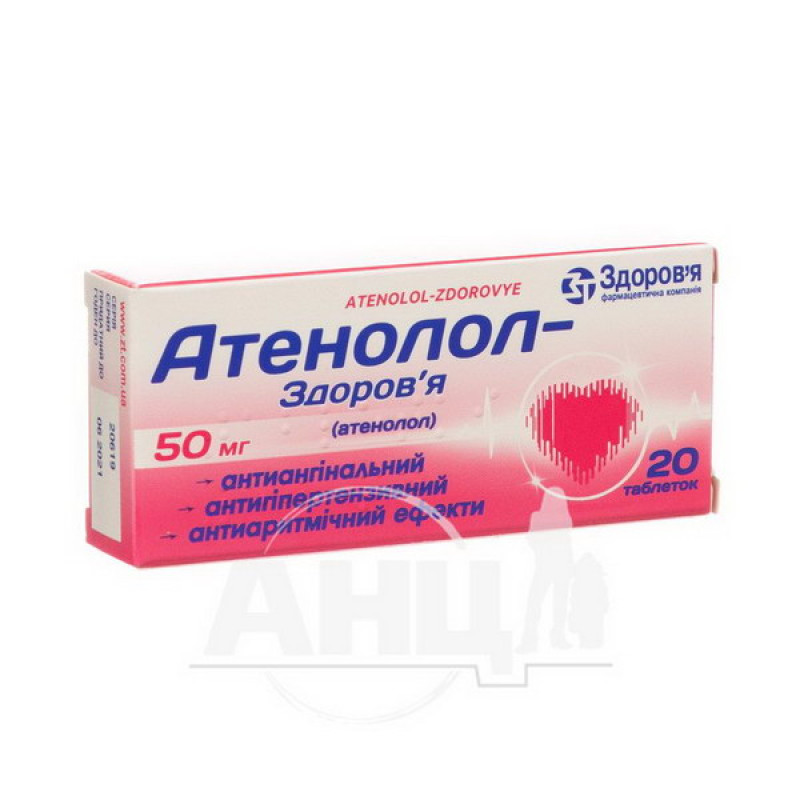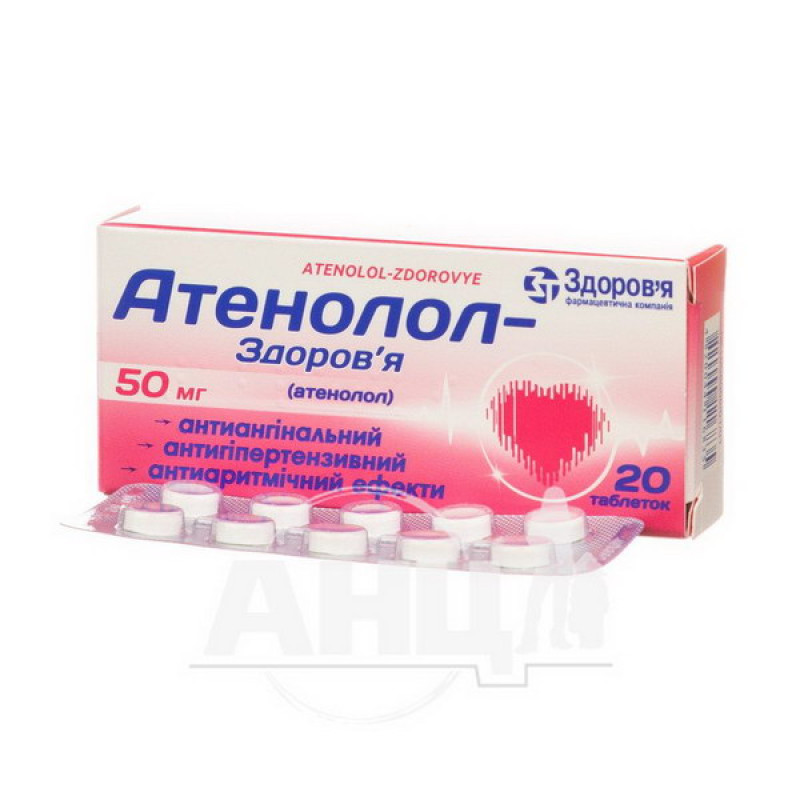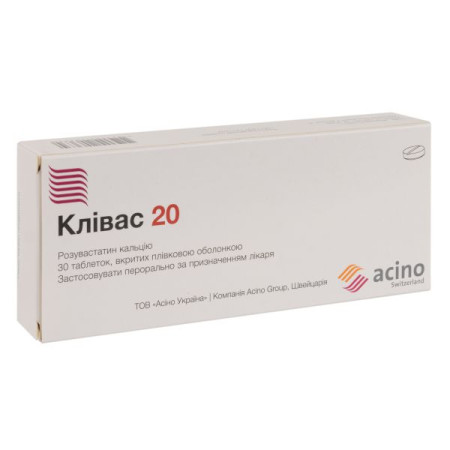Atenolol-Health tablets 50 mg blister No. 20

Pharmacological properties
Atenolol (4-[2-(hydroxy-3-isopropylaminopropoxy)phenyl]acetamide) is a selective β1-adrenoceptor blocker. Unlike non-selective β-adrenoceptor blockers, atenolol, when used in medium therapeutic doses, does not affect the β2-adrenoceptors of the bronchi and blood vessels. Cardioselectivity is lost when taking large doses of the drug. It has antianginal, hypotensive and antiarrhythmic effects. It reduces systolic and diastolic heart rate, sinus node automatism, heart rate, slows AV conduction, reduces myocardial contractility and its oxygen demand.
Up to 50% of the drug is absorbed in the digestive tract. The maximum concentration in the blood plasma is reached 2-4 hours after taking the drug. Atenolol is metabolized to a small extent in the liver (less than 10%). It is excreted mainly in the urine. The half-life is 6-7 hours, in patients with renal failure it may be prolonged.
Indication
Ag, coronary heart disease (prevention of angina attacks), prevention and treatment of supraventricular tachyarrhythmias.
Application
The dose is set individually. For angina pectoris, atenolol-zt is prescribed at a dose of 50-100 mg per day (in 1-2 doses); if necessary, the dose is increased to 200 mg per day (in 2 doses). For arrhythmia, it is prescribed at a dose of 50-100 mg per day in 1-2 doses. For atrial fibrillation, it is prescribed at an initial dose of 50 mg once a day. According to indications, the dose is increased to 100 mg 1-2 times a day. The maximum daily dose is 200 mg.
Correction of the dosage regimen is necessary in case of impaired renal excretory function: with creatinine clearance below 35 ml/min, the dose of the drug is reduced by 50%, with clearance below 15 ml/min - by 75%.
Atenolol-ST is recommended to be taken before meals, without chewing and with a small amount of water. Experience with the drug in children is insufficient.
Contraindication
Sinoauricular block, AV block II-III degree, bradycardia (heart rate less than 50 per 1 min), sick sinus syndrome, arterial hypotension, chronic heart failure IIb-III stage, acute heart failure, metabolic acidosis, ba.
Side effects
At the beginning of treatment, orthostatic hypotension, headache, depression, increased sweating, sleep disturbances, nausea, constipation, diarrhea, itching, a feeling of coldness in the extremities, in isolated cases - AV conduction disorders, circulatory failure, severe bradycardia, arterial hypotension, heart failure, hypoglycemic state in patients with diabetes, conjunctivitis are possible.
Special instructions
Atenolol-ZT, like other β-adrenergic blockers, should be discontinued in patients with coronary artery disease gradually, as abrupt discontinuation of the drug may result in worsening of angina and myocardial ischemia, and decreased exercise tolerance. Cardioselectivity of atenolol-ZT allows it to be used with caution in the treatment of patients with COPD in cases of resistance to other antihypertensive drugs. The drug is prescribed in the minimum effective doses.
Atenolol-ST should be prescribed with caution to patients with diabetes mellitus, since β-blockers may mask the symptoms of hypoglycemia and potentiate the hypoglycemic effect of antidiabetic agents.
Beta-blockers can mask the severity of some clinical manifestations of hyperthyroidism (eliminate tachycardia). Their sudden cancellation can provoke the development of thyrotoxic crisis, so when canceling Atenolol-ST, medical supervision is required. The use of Atenolol-ST during pregnancy and breastfeeding is indicated only in cases where the expected therapeutic effect for the mother outweighs the risk of negative effects on the fetus or infant.
Interactions
When atenolol is used simultaneously with insulin, oral hypoglycemic drugs, and antihypertensive drugs, the effect of the latter is enhanced.
With simultaneous use of atenolol-ZT with reserpine, methyldopa, clonidine, guanfacine, verapamil, the development of pronounced bradycardia is possible. With simultaneous treatment with clonidine, its administration can be stopped only a few days after the withdrawal of atenolol-ZT. It is necessary to use the combination of Atenolol-ZT with verapamil with special caution, since this is associated with an increased risk of developing bradycardia and AV conduction disorders. Like other β-adrenoreceptor blockers, Atenolol-ZT is not recommended for use simultaneously with neuroleptics, tranquilizers and MAO inhibitors.
Overdose
Initial manifestations of overdose are drowsiness, shortness of breath, stridor, bradycardia. Congestive heart failure, hypotension, bronchospasm and hypoglycemia may develop. In case of overdose, gastric lavage is performed, activated charcoal is administered orally, glucagon is administered. In case of bradycardia or AV blockade, atropine or isoprenaline is administered; if drug treatment is ineffective, electrocardiostimulation is used; in case of congestive heart failure, digitalization and diuretics are prescribed.
Storage conditions
In a dry place, protected from light.
There are no reviews for this product.
There are no reviews for this product, be the first to leave your review.
No questions about this product, be the first and ask your question.









